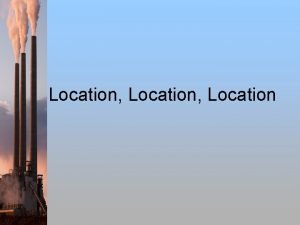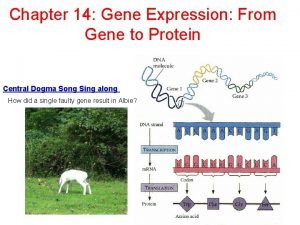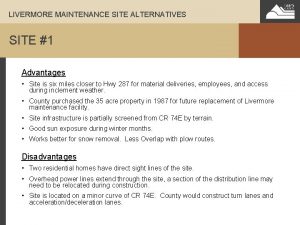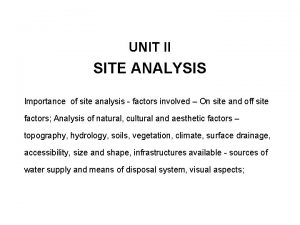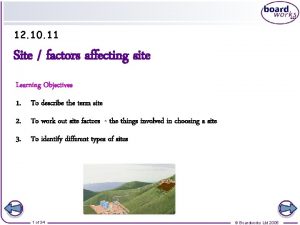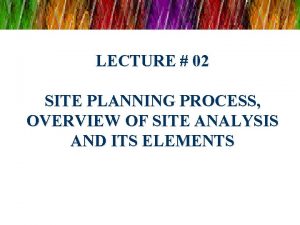LECTURE 03 SITE ANALYSIS FACTORS SITE ANALYSIS FACTORS






































- Slides: 38

LECTURE # 03 SITE ANALYSIS FACTORS

SITE ANALYSIS FACTORS ØThe analysis of the site and its environs includes various factors and features that affect it. ØThese factors influence final site selection and provide clues in establishing guidelines for later development. ØBroadly these factors are categorized as: 1. Natural Factors 2. Biological Factors 3. Cultural/Aesthetic Factors

THE NATURAL FACTORS

SITE INVENTORY NATURAL FACTORS Categories Attributes Soils • Types • Bearing capacity • Porosity • Stability • Erosion • Fertility • Acidity (p. H) Hydrology • Surface drainage • Water chemistry (e. g. , salinity nitrates or phosphates) • Depth to seasonal water table • Aquifer recharge areas • Seeps and springs

SITE INVENTORY NATURAL FACTORS Categories Attributes Physiography • Geomorphology • Topography • Landforms • Slope • Relief and Elevation Geology • Seismic hazards • Depth to bedrock • Surficial rocks Climate • Winds (i. e. , prevailing or winter • Fog pockets • Solar orientation • Precipitation • Humidity

1. SOILS q. In site planning, it is important to establish the relationship between soil composition and land uses (other than agriculture). q. Soil surveys help guide in site selection for residential, industrial, and other forms of development that involve surface and subsurface structures. q. Main features to describe soil for use in site design include: ü Soil composition and texture ü Erosion/ Erodability SITEPLANNINGREVIEW

SOIL SUITABILITY q. Soil suitability for land uses should be studied particularly for: ü Type and size of a building’s foundation system ü Dwellings with basements ü Drainage of ground and surface water ü Absorption fields for septic tanks ü Types of plant material able to grow on a site ü Streets and parking ü ponds or reservoir areas ü Recreational facilities

SOIL EROSION q. Soil erosion – when rocks are broken down (weathered) into small fragments, and carried by wind, water, ice and gravity. q. Four factors need to be considered erosion rates: ü Vegetation ü Frequency and intensity of rainfall ü Soil type ü Slope size and inclination S I T E P L ANNI NG R E VI E in forecasting

SOIL EROSION 1. Vegetation: • • Foliage intercepts raindrops Organic litter on the ground reduces impact of raindrops Roots bind together aggregate of soil particles Cover density, in form of ground cover or tree canopy, decreases soil loss to runoff 2. Frequency and Intensity of Rainfall • Intensive rainfalls produced by thunderstorms promote the highest rates of erosion. • Accordingly, the incidence of storms plus total annual rainfall can be a reliable measure of the effectiveness of rainfall in promoting soil erosion.

SOIL EROSION 3. Soil Type: • Intermediate textures like sand will usually yield (erode) first. • To erode clay, the velocity of the runoff should be high enough to overcome cohesive forces that bind the particles together. • Similarly, high velocities would be needed to move masses of pebbles and particles larger than those of sand. 4. Slope Size and Inclination: • The velocity of runoff is closely related to the slope of the ground over which it flows. Slopes that are both steep and long produce the greatest erosion because they generate runoff that is high in velocity and mass. • Slope also influences the quantity of runoff since long slopes collect more rainfall and thus generate a larger volume of runoff.

SOIL COMPOSITION & TEXTURE ØComposition and texture are generally the most meaningful; from them we can make inferences about bearing capacity, internal drainage, erodibility, and slope stability. ØComposition refers to the material that makes up soil including mineral particles, organic matter, water, and air. ØMineral Particles comprise 50% to 80% of the volume of the soil and form the all important skeletal structure of the soil. ØBearing capacity is a soil’s resistance to penetration from a weighted object such as a building foundation.

SOIL COMPOSITION & TEXTURE ØOrganic Matter varies radically in soils and usually imposes a limitation to any building structure. Organic matter is important only for soil fertility, moisture absorption and retention and for landscaping. ØWater content varies with particle sizes, local drainage, topography and climate. Most water occupies the spaces between particles; only in organic soils do the particles themselves actually absorb measurable amounts of water. ØAir is what occupies remaining space that is not occupied by water. In layers where groundwater is formed by gravity water in the subsoil and underlying rock, there is absence of air.

SOIL COMPOSITION & TEXTURE ØTexture is the term used to describe the composite sizes of particles in a soil sample. ØThere are 12 basic terms for texture, at the center of which is Class loam, which is an intermediate mixture of 40% sand, 40% silt and 20% clay.

HAZARDOUS SOIL CONDITIONS ØExpansive soils usually pose a threat of hazardous soil conditions. ØImpact of expansive soils may be: üExtensive cracking of sidewalks, üFoundation failures, üRetaining wall failure, and so on. ØThe description of expansive soils recognition in the field is given below: Under Dry Conditions üSoil is hard and almost rocklike; difficult to impossible to crush by hand. üGlazed, almost shiny surface where previously cut by shovel or scraper. üVery difficult to penetrate with pick or shovel. üSurface irregularities such as tire tracks cannot be obliterated by foot pressure.

HAZARDOUS SOIL CONDITIONS üGround surface displays cracks occurring in a more or less regular pattern. Crack width and spacing are indicative of relative expansion potential in horizontal plane. Under Wet Conditions üSoil very sticky. Exposed soil will accumulate on shoe soles to a thickness of 2 -4 inches when walked upon for a short distance. üSoil can be molded into a ball by hand. Hand molding will leave a nearly invisible powdery residue on hands after they dry. üA shovel will penetrate soil quite easily, and the cut surfaces will be smooth and tend to be shiny. üFreshly machine scraped or cut areas will tend to be smooth and shiny. üHeavy construction equipment such as bulldozers and compacting rollers will develop a thick soil coating, which may impair their function.

2. HYDROLOGY ØHydrology – the natural science that studies the Waters of the Earth, their occurrence, circulation and distribution, their chemical and physical properties, and their reaction to the living environment including their relation to all living things. ØHydrologic cycle – or the planet’s water cycle, described by the movement of water from the oceans to the atmosphere to the continents and back to the sea. ØHydrological features are of primary importance for developing the site drainage patterns.

SITE DRAINAGE PATTERNS ØBoth the surface and the sub-surface drainage patterns on a site may greatly influence land use. ØAll water bodies including rivers, drainage channels, marshes, wetlands, floodplains and aquifers , must be inventoried analyzed for their opportunities or constraints.

MARSHES, FLOODPLAINS & AQUIFERS ØMarshes may be a scarce or unique feature requiring protection because of associated wildlife habitat of much value. ØFloodplains must also be studied carefully for 100 years storms and some recreational uses may be located in floodplains. ØAquifers are water-bearing strata of rock, gravel, or sand in which groundwater is stored. Being very valuable resource of potable water, they should be protected from septic systems and sewer lines etc. They can both store and transmit groundwater in significant quantities ØWatershed is a geographic area of land bounded by topographic features and height of land that captures precipitation, filters and stores water and drains waters to a shared destination.

3. PHYSIOGRAPHY ØPhysiography is the branch of Geography that deals with the description of landforms. ØLandforms are irregularities on the earth’s surface which are derived from volcanic, glacial, or erosional processes. ØKnowledge of their kinds and characteristics will influence the planning and design if the site is part, of or encompasses, such an irregularity. ØThe branch of Physiography which deals with the origin and nature of Landforms is known as Geomorphology.

TOPOGRAPHY ØTopography describe the shape and relief of land. It is a measurement of elevation and relief of the land. ØIt is measured with contours that connect points representing the same elevation. ØThe topography of a site may dictate the purposes for which the site may be practically used and eventually the layout of the proposed project. ØThe location of buildings and roads, pedestrian circulations and the arrangement of other features are all commonly affected by topography.

CONTOUR LINES ØContour lines are imaginary lines in plan view that connect points of equal height above a datum or bench mark. ØContour lines spaced far apart indicate a flat surface. ØContour lines spaced evenly describe a constant slope. ØContour lines spaced closer together designate a steep rise/fall in elevation.

TOPOGRAPHIC FEATURES ØFollowing topographic features are considered for site analysis: üLocation of the structure on the site üLocation and sizes of storm and sewerage systems üOutline of wooded areas üHydrographic features (river, lake, etc. ) üLocation of utility lines/services üSlope analysis üViews üApproach and the means of accessing the site üIdentification of unique habitats üNeighboring land-uses üRight of ways, easements and other encroachments üRoad elevations

SLOPE ANALYSIS ØSlope is the measure of steepness or the degree of inclination of a feature relative to the horizontal plane. Gradient, grade, incline and pitch are used interchangeably with slope. Slope is typically expressed as a percentage, an angle, or a ratio. ØSlope analysis produces an overall pattern of slopes which helps the site planner in determining the buildable portions of the site. ØThese grades are calculated by measuring the distance between contours (D) at a given scale and contour interval (CI).

SLOPE ANALYSIS ØHow to calculate Grade? %Grade = CI/D * 100 ØIf D = 40 FT, AND CI = 2 ft, the Grade will be: %Grade = 2/40 * 100 = 5%

DESIRABLE SLOPE ØThe slopes can be divided into following classes: ü 0 – 5% Generally flat Highly buildable ü 5 – 10% Gently rolling Moderately buildable ü 10 – 15% Gentle to mild slopes Moderately difficult to build ü 15 – 20% Mild to steep slopes Difficult to build ü 20% and over Harsh, steep slopes Unbuildable ØFlat or gently sloping sites are preferred for industrial and commercial buildings. ØHilly sites are preferred for terraced suburban residences. ØSlopes influence the alignment of modern roads according to class of roads; the higher the class, the lower the maximum grades allowable.

4. GEOLOGY ØGeology is the natural science that studies the Earth – its composition; the processes that shaped its surface; and its history. ØEarth is made up of rocks (including soil, sand, silt and dust); rocks are composed of minerals; minerals are made up of atoms. ØTo understand the processes that have occurred in the past, it is useful to review the historical evolution of a region, like: üWhich geological processes have affected the site? , üWhat is the formation and the type of bedrock below the surface of the soil? , etc.

TYPES OF ROCKS üIgneous Rocks üSedimentary Rocks üMetamorphosed Rocks

IGNEOUS ROCKS ØIgneous rock is formed through the cooling and solidification of magma or lava. ØIgneous rock may form with crystallization to form granular, crystalline rocks, or without crystallization to form natural glasses.

SEDIMENTARY ROCKS ØSedimentary Rocks – when igneous rocks are exposed to surface and weathering reduces them to particles, these particles are moved by erosional process and deposited in layers into rivers and oceans. ØThese are formed by the deposition and subsequent cementation of that material at the Earth’s surface and within bodies of water.

METAMORPHOSED ROCKS ØMetamorphosed Rocks – when sedimentary rocks are pushed to deeper levels of the earth, they transform into metamorphosed rocks due to changes in pressure and temperature. ØMetamorphism is a change in the structure or composition of a rock due to natural agencies, as pressure and heat. Especially when the rock becomes harder and more completely crystalline.

WHAT IS A BEDROCK? ØBedrock is consolidated rock material lying at various depths below all points of the earth’s surface. ØThe type and depth of bedrock presents many questions of its adequacy as a base for foundations of walls, or roads. ØTest boring can be taken at several locations on the site and a Soil Engineer can be consulted to facilitate the interpretation of the boring results.

SURFICIAL GEOLOGIC MATERIALS ØAbove Bedrock, surficial geologic materials extend to the surface soil. ØThese materials may be of porous and serve as aquifers. ØSame regions are prone to movement of the earth’s surface by: üTactonic Movements (through crustal stress, shock by earthquakes). or üMovement caused by Surficial Pressures (including rock falls, landslides, mudflows, and soil creep etc. )

5. CLIMATE ØClimate is one of the very important factors and sites should be analyzed and planned comprehensively keeping in view the overall climate. ØClimates can be divided in five general types: üTropical üDry/ Arid üTemperature üCold üPolar

ROLE OF SITE PLANNER ØSite planner should investigate all the climatic factors and especially: üThe solar orientation for the buildings, üThe best facing slopes, and üThe part of the slope that makes use of airflow for warmth in cool climates or for breezes in temperature or hot climates.

MAIN CLIMATIC FEATURES ØImportant climatic considerations are: üHumidity, üTemperature, üPrecipitation and Wind direction, üSolar orientation, and üFog.

HUMIDITY ØHumidity is the amount of water vapor in the air. ØRelative humidity is the amount of water vapor the air is holding, expressed as a percentage of the amount the air can hold at a particular temperature. ØIf at a particular temperature, air is saturated with water vapor, it has 100% relative humidity. ØWarmer temperatures are capable of holding more water vapor before saturation is reached.

TEMPERATURE ØTemperature is another very important factor considering the energy consumption during hot and cold weather. ØFor each 300 ft. Rise in height from the earth’s surface, temperature decreases approximately 1° F in the summer. ØOceans and large lakes retain their heat in winter months as land masses cool and they are cool in summer as land masses warm, thus moderate the temperature. ØThe more perpendicular a slope is to the rays of the sun, the warmer the surface temperature.

PRECIPITATION AND WIND DIRECTION ØThe movement of water particles into air is precipitation and it along with temperature are the major factors affecting vegetation. ØWind direction, also plays an essential role in site selection. ØIn cool and temperate climates, vegetation may be used to block winter winds. ØCool air flows towards low points or valleys at night, but higher side slopes remain warmer.
 01:640:244 lecture notes - lecture 15: plat, idah, farad
01:640:244 lecture notes - lecture 15: plat, idah, farad Location situation
Location situation Location situation
Location situation Hot site cold site warm site disaster recovery
Hot site cold site warm site disaster recovery Site analysis factors
Site analysis factors What is site inventory
What is site inventory Exploratory data analysis lecture notes
Exploratory data analysis lecture notes Sensitivity analysis lecture notes
Sensitivity analysis lecture notes Factor analysis lecture notes
Factor analysis lecture notes Analysis of algorithms lecture notes
Analysis of algorithms lecture notes Streak plate
Streak plate Power system analysis lecture notes
Power system analysis lecture notes Biotic and abiotic drawing
Biotic and abiotic drawing Abiotic vs biotic factors
Abiotic vs biotic factors Abiotic vs biotic factors
Abiotic vs biotic factors Biotic and abiotic factors definition
Biotic and abiotic factors definition What are all the factors of 48
What are all the factors of 48 Common factors of 10 and 20
Common factors of 10 and 20 Fctors of 8
Fctors of 8 Key issue 2 why are situation and site factors important
Key issue 2 why are situation and site factors important Bridge site selection
Bridge site selection What is a site and p site of ribosome
What is a site and p site of ribosome Untangle openvpn setup
Untangle openvpn setup Project procurement management lecture notes
Project procurement management lecture notes Lecture about sport
Lecture about sport Lecture on healthy lifestyle
Lecture on healthy lifestyle Makeup lecture meaning
Makeup lecture meaning Life lecture meaning
Life lecture meaning Randy pausch last lecture summary
Randy pausch last lecture summary Tensorflow lecture
Tensorflow lecture Theology proper lecture notes
Theology proper lecture notes Strategic management lecture
Strategic management lecture Geology lecture series
Geology lecture series Social psychology lecture
Social psychology lecture In text citation for a lecture
In text citation for a lecture Public sector accounting lecture notes in uganda
Public sector accounting lecture notes in uganda Software project management lecture notes
Software project management lecture notes Eurocode reinforcement detailing
Eurocode reinforcement detailing Magnetism
Magnetism


